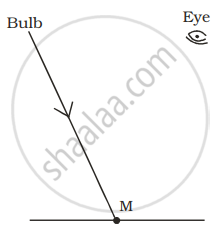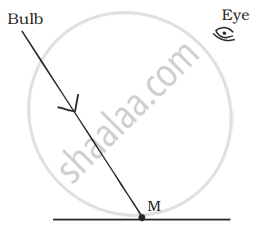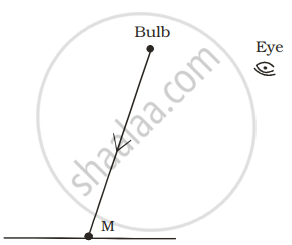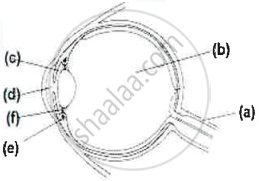Advertisements
Advertisements
Question
Give scientific reason:
We cannot clearly see an object kept at a distance less than 25 cm from the eye.
Solution
- The muscles attached to the eye lens (ciliary muscles) help in fine adjustments of the focal length of the lens.
- The capacity of these muscles to contract or relax to adjust the focal length (i.e., power of accommodation) has a limit.
- The minimum distance of an object from a normal eye for which the eye lens can decrease its focal length to the least possible value, is 25 cm.
Hence, we cannot clearly see an object kept at a distance less than 25 cm from the eye.
RELATED QUESTIONS
Distinguish between: aqueous humor and vitreous humor
Explain the mechanism of vision.
Match the following:
| Column I | Column II |
| (i) Myopia | (a) Converging power of eye lens becomes low |
| (ii) Hypermetropia | (b) Converging power of eye lens remains the same |
| (c) Converging power of eye lens becomes high |
Where is the image formed in a human eye?
Give the scientific names of the following parts of the eye:
carries signals from an eye to the brain.
Give the scientific names of the following parts of the eye:
a hole in the middle of the iris.
How is the amount of light entering the eye controlled?
List, in order, the parts of the eye through which light passes to reach the retina.
A student sitting on the last bench in the class cannot read the writing on the blackboard clearly but he can read the book lying on his desk clearly. Which of the following statement is correct about the student?
(a) The near point of his eyes has receded away.
(b) The near point of his eyes has come close to him.
(c) The far point of his eyes has receded away.
(d) The far point of his eyes has come closer to him.
Out of animals of prey and predators, which have their eyes:
at the front of their head?
Name two animals having eyes:
at the front of the head.
The animals of prey have:
(a) two eyes at the front
(b) two eyes at the back
(c) two eyes on the sides
(d) one eye at the front and one on the side
Name the following:
The photoreceptors found in the retina of the eye.
Mention if the following statement is true (T) or false (F) Give reason.
Ciliary muscles regulate the size of the pupil
Mention if the following statement is true (T) or false (F) Give reason.
Blind spot is called so because no image is formed on it.
What is a lacrimal gland?
With reference to the functioning of the eye, answer the question that follow:
Name the cells of the retina and its respective pigments which get activated in the light.
The figure below compares a part of our eye with a part of a photographic camera.

Name the corresponding parts of the eye the camera shown here that are comparable in function.
State the main functions of the following:
Seminal Vesicles
Name the following:
Short sightedness.
Name the respective organs in which the following are located and mention the main function of each:
(i) Iris
(ii) Semicircular canals
Give the main function of the following:
Three semicircular canals
Give the main function of the following:
Lachrymal glands
Name the following:
The opening through which light enters the eyes.
Choose the correct answer.
In the chemistry of vision, the photosensitive substance is _________________
What is a Lachrymal gland?
State the Function:
Aqueous humour
State the Function:
Vitreous humour
Choose the Odd One Out:
For the normal human eye, the near point is at ___________ cm.
Draw a scientifically correct labelled diagram of a human eye and answer the questions based on it:
- Name the type of lens in the human eye.
- Name the screen at which the maximum amount of incident light is refracted?
- State the nature of the image formed of the object on the screen inside the eye.
Name the capacity of the eye lens to change its focal length as per need.
Write the name.
The screen with light sensitive cells in human eye.
Write an Explanation.
Minimum distance of distinct vision
Complete the paragraph by choosing the right options given below.
(minimum, near point, 25 cm, farthest, farthest distance, far point)
The _______ distance of an object from a normal eye, at which it is clearly visible without stress on the eye, is called the minimum distance of distinct vision. The position of the object at this distance is called the _______ of the eye, for a normal human eye, the near point is at _______. The _______ distance of an object from a human eye, at which it is clearly visible without stress on the eye is called _______ of distinct vision. The position of the object at this distance is called the _______ of the eye.
______ is tough and thick white sheath that protects the inner parts of the eye.
A tiny mirror M is fixed on a piece of cardboard placed on a table. The cardboard is illuminated by light from a bulb. The position of eye with respect to position of bulb is shown in the figure as A, B, C and D. In which position mirror will be visible?
 |
 |
 |
 |
| (A) | (B) | (C) | (D) |
Vitreous humour is present between ______.
Given below is a cross section of the human eye. Match the structures marked (a) to (e) with their correct functions:
Example: (f) - 6. Holds the lens in position
| Cross section of Human Eye | Functions | |
 |
1. | Protects retina |
| 2. | Regulates the size of the pupil | |
| 3. | Alters the shape of the lens | |
| 4. | Keeps the lens moist | |
| 5. | Transmits nerve impulses to brain | |
| 6. | Holds the lens in position |
Name the following:
Kind of retinal cells sensitive to dim light.
